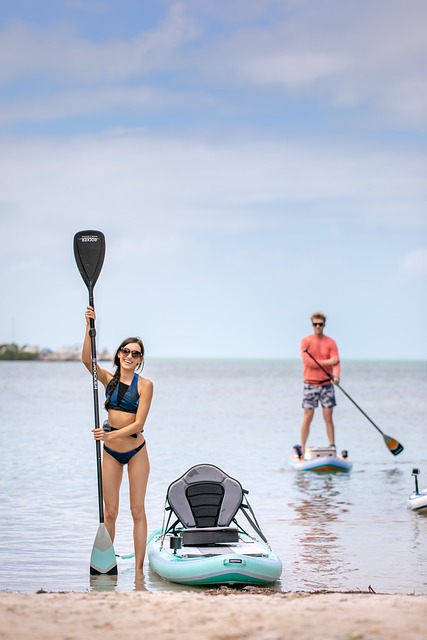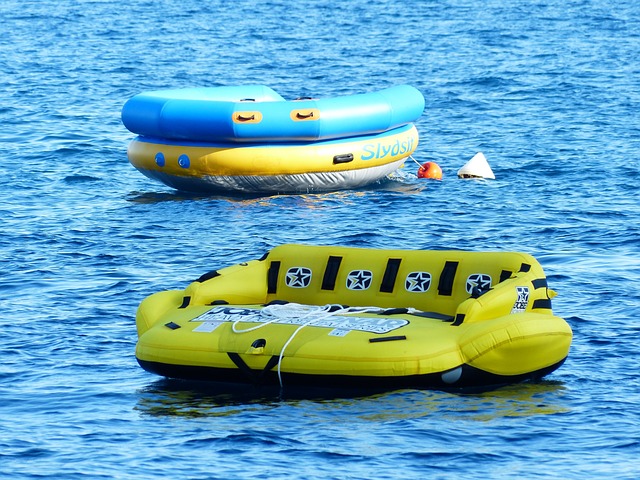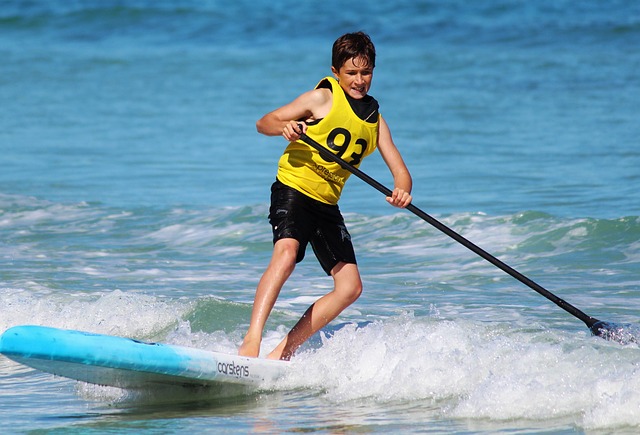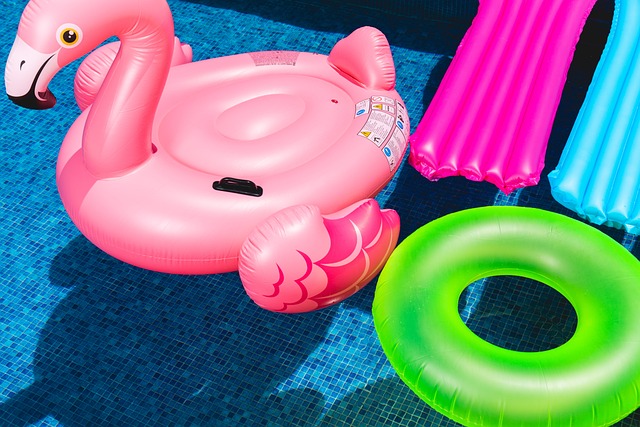Inflatable paddle boards (iSUPs) are versatile and user-friendly watercraft suitable for a range of activities including stand-up paddling (SUP), surfing mild waves, and sit-on-top leisure paddling. They offer the benefits of being lightweight, transportable, and easily deflatable, making them an excellent choice for those who value both convenience and performance on the water. iSUPs are crafted with durable materials that ensure sturdiness and flexibility, and they come equipped with features like adjustable fins, D-rings, handles, and bungee cords for gear storage, as well as wide deck pads for comfort and safety. Whether you're looking for an active fitness activity or a calm, serene float, there's an iSUP to suit your needs, with both stand-up and sit-on-top models available to cater to different preferences and use cases. Choose the right iSUP based on your intended use, comfort, and desired on-water experience to fully enjoy the unique advantages that inflatable paddle boards offer for aquatic exploration and recreation.
Discover the dynamic world of inflatable paddle boards, where both stand-up and sit-down options offer unique experiences on the water. This article delves into the versatility and rising popularity of these portable and user-friendly boards, perfect for a range of activities and skill levels. From the techniques and benefits of stand-up paddle boarding (SUP) to the comfort and accessibility of sit-down paddling, learn about the design features that enhance performance and stability in inflatable paddle boards. Additionally, we’ll guide you through comparing the two, ensuring you choose the right one for your lifestyle, and provide essential maintenance tips to keep your board in top condition. Join us as we navigate the best of inflatable paddle boarding.
Exploring the Versatility of Inflatable Paddle Boards: Stand-Up or Sit-Down?

Inflatable paddle boards have revolutionized the way enthusiasts engage with paddlesports, offering unparalleled versatility and convenience. These boards are designed with a high level of buoyancy and durability, making them suitable for both stand-up paddling (SUP) and sit-down paddling. For those who prefer the traditional SUP experience, inflatable paddle boards provide a stable platform that allows for full body engagement and the opportunity to harness the full potential of each paddle stroke. The inflatable design ensures that these boards are easy to transport and store, as they can be rolled up and fit into compact carrying cases. This portability means that adventurers can access a wider range of environments, including remote lakes and fast-flowing rivers, without the constraints of rigid board logistics.
On the other hand, for those who find standing for extended periods challenging or prefer a more relaxed paddling experience, sit-down paddling on an inflatable paddle board is an excellent alternative. These boards come with seats that can be attached for comfort and support, making them ideal for longer excursions or for paddlers of all ages and abilities. The adjustable nature of these boards also means that they can accommodate different paddling styles and body types, further enhancing their user-friendly appeal. Whether you’re a seasoned paddle sport athlete or a novice looking to explore the waterways, inflatable paddle boards offer a flexible and engaging option that caters to both stand-up and sit-down paddling preferences. Their adaptability makes them a top choice for anyone looking to enjoy the outdoors on the water.
The Rise of Inflatable Paddle Boards: Accessibility and Convenience

In recent years, inflatable paddle boards have become a popular staple in the world of water sports, offering a blend of accessibility and convenience that has broadened their appeal to both seasoned enthusiasts and novices alike. The rise of these inflatable boards can be attributed to their compact and transportable nature, making them an ideal option for those with limited storage space or who prefer a more mobile paddling experience. Unlike their rigid counterparts, inflatable paddle boards can be easily deflated and rolled up, fitting neatly into a bag for effortless transportation. This portability means that adventure seekers can now take their passion for paddle boarding to remote locations previously inaccessible to traditional paddle boards. Moreover, the inflatable paddle board’s durability and buoyancy have advanced significantly, ensuring stability and safety on the water while also withstanding various environmental conditions without compromise on performance. As a result, these versatile boards have democratized access to paddling sports, allowing more individuals to enjoy the myriad of benefits that come with this activity, from improving physical fitness to experiencing the tranquility of being on the water. The inflatable paddle board trend continues to gain momentum, with manufacturers innovating further to enhance user experience and cater to diverse preferences and skill levels. Whether for yoga, fishing, or recreational paddling, the inflatable paddle board market has something to offer, underscoring its position as a standout option in the realm of outdoor activities.
Stand-Up Paddle Boarding (SUP): Techniques, Benefits, and Best Practices

Stand-up paddle boarding, commonly known as SUP, has surged in popularity due to its accessibility and versatility. This engaging sport not only offers a full-body workout but also provides a unique perspective of aquatic environments, promoting both physical health and mental well-being. When considering an inflatable paddle board for your SUP adventures, it’s crucial to select one that suits your body type, skill level, and intended environment. Inflatable boards offer the advantage of portability and durability, making them ideal for a variety of conditions, from calm lakes to ocean waves. Proper technique is essential in SUP; beginning with an even distribution of weight and maintaining a strong core throughout your paddle strokes will enhance stability and efficiency on the board. Engaging in regular exercises that strengthen your back, shoulders, arms, core, and legs will further improve your performance. Additionally, mastering the basics, such as effective paddling techniques and falls management, is key to safety and enjoyment. Best practices for SUP with an inflatable paddle board include regularly checking the board’s air pressure to maintain optimal performance, securing the leash for added safety, and always being mindful of local waterway regulations. By adhering to these techniques and best practices, paddle boarders can maximize their experience on the water and fully appreciate the recreational and health benefits that SUP offers.
Sit-Down Paddle Boarding: A Comfortable Alternative for All Ages and Skill Levels

When considering the various ways to enjoy the serene waters, sit-down paddle boarding stands out as a versatile and accessible activity suitable for all ages and skill levels. Unlike traditional stand-up paddle boarding, this approach allows users to sit comfortably on the deck of an inflatable paddle board, offering a more relaxed experience that can be particularly appealing to those new to paddling or individuals with balance concerns. The inflatable paddle board, designed with durability and portability in mind, provides a stable platform from which to explore lakes, rivers, and calm seas. Its enhanced buoyancy and wide deck pad offer additional stability and comfort, making it an excellent option for families, older adults, or anyone seeking a leisurely paddling experience without the need for extensive core strength or balance.
The sit-down paddle boarding trend has gained momentum due to its inclusivity and ease of use, especially when paired with the practicality of inflatable models. These boards are often equipped with ergonomic seats and footrests to optimize comfort during longer excursions or casual paddles. The inflatable nature of these boards also means that they can be easily transported and stored, opening up paddling opportunities for those with limited vehicle space or who travel frequently. Whether for a leisurely day on the water or as a gateway activity to eventually transition into stand-up paddle boarding, sit-down paddle boarding on inflatable boards offers an accessible, comfortable, and enjoyable way to enjoy the tranquility of aquatic environments.
Inflatable Paddle Boards: Design and Features for Optimal Performance and Stability

When considering the stand-up or sit-down options for paddlers, inflatable paddle boards (iSUPs) have emerged as a versatile and user-friendly choice. These boards are designed with a focus on optimal performance and stability, making them suitable for a variety of water conditions and skill levels. The construction of iSUPs involves high-quality, durable materials that provide both rigidity and flexibility; the inflatable nature allows for easy transport and storage, as they can be compactly rolled up and placed in a bag when not in use. A key feature of these boards is their wide deck pad, which offers a stable platform for both standing and sitting paddlers, ensuring comfort and safety during your aquatic adventures. The deck pad also adds traction, preventing slips and falls, which is particularly beneficial for beginners or those practicing yoga on the water.
The design of inflatable paddle boards often incorporates an array of D-rings, handles, and bungee cords for securing gear, which is essential for longer excursions where storage space is at a premium. Additionally, most iSUPs come with a fin system that can be adjusted to match the water conditions; this allows paddlers to optimize their board’s tracking and maneuverability. The fins help in maintaining a straight path, reducing the effort needed to paddle, and enhancing the overall experience on the water. The inflatable paddle board’s design also takes into account airflow and heat dispersion; this is achieved through various chambers or a single chamber with a high-pressure valve, which maintains the board’s shape and performance regardless of external temperature fluctuations. With these thoughtfully integrated features, inflatable paddle boards are an excellent choice for those seeking a reliable, accessible, and enjoyable way to explore the world from a different perspective.
Comparing Stand-Up vs. Sit-Down Inflatable Paddle Boards: What's Right for You?

When considering the purchase of an inflatable paddle board, one of the first decisions to make is whether a stand-up paddle board (SUP) or a sit-on-top model best suits your needs. Both styles offer unique advantages and cater to different preferences in terms of comfort, stability, and intended use.
Stand-up paddle boards are designed for riders to actively stand while propelling themselves through the water with a paddle. This positioning not only engages the core muscles but also offers superior maneuverability and speed for those looking to cover greater distances or surf small waves. The inflatable nature of these SUPs ensures they are lightweight, easy to transport, and can be deflated for storage. They are an excellent choice for fitness enthusiasts, surfers, or anyone seeking a dynamic paddling experience on calm waters.
On the other hand, sit-on-top inflatable paddle boards provide a more relaxed paddling position, which can be particularly comfortable for longer outings. They are well-suited for beginners due to their inherent stability and are ideal for those who want to enjoy a leisurely paddle with a wider range of motion. These boards are also great for individuals looking to bring along a pet or a child, as there is ample space on the deck for passengers. Additionally, sit-on-top inflatable paddle boards can accommodate accessories like seats and coolers, making them versatile for various recreational activities. When choosing between stand-up and sit-down inflatable paddle boards, consider your intended use, personal comfort, and the type of experience you’re looking to have on the water. Each option provides a unique set of benefits that can transform your time on the water into an enjoyable and fulfilling activity.
Maintenance and Care for Your Inflatable Paddle Board: Ensuring Durability and Longevity

When it comes to maintaining and caring for your inflatable paddle board, adhering to a few key practices can greatly enhance its durability and longevity. Regularly rinse your board with fresh water after each use to remove saltwater, sand, or any other debris that could accelerate wear and tear. Store the board in a cool, shaded area away from direct sunlight, which can degrade material quality over time.
To maintain the integrity of your inflatable paddle board, always use the appropriate inflation pressure as recommended by the manufacturer. This ensures optimal performance and protection against over-expansion that could potentially compromise the board’s structure. Additionally, regularly check the seams and valves for any signs of damage or wear. Repairing these issues promptly can prevent more significant problems down the line. Use a repair kit specifically designed for inflatable paddle boards to address any punctures or tears as soon as they occur. By following these maintenance and care guidelines, you can enjoy your inflatable paddle board for many seasons to come.
